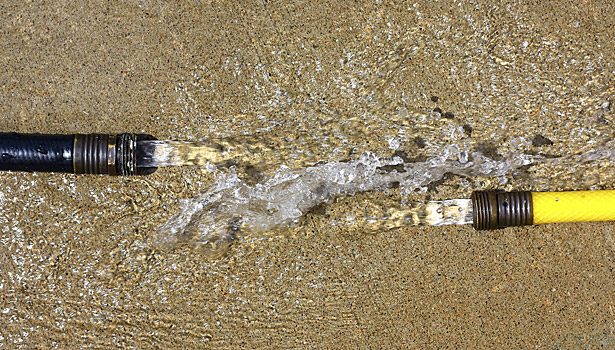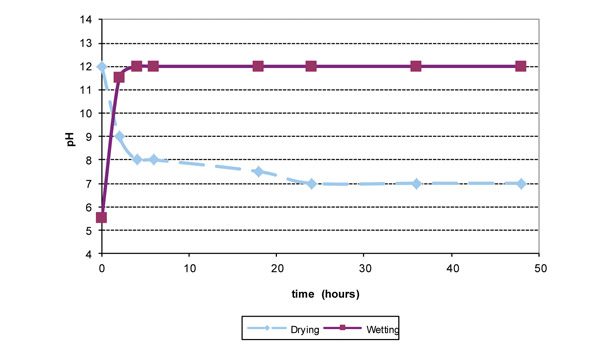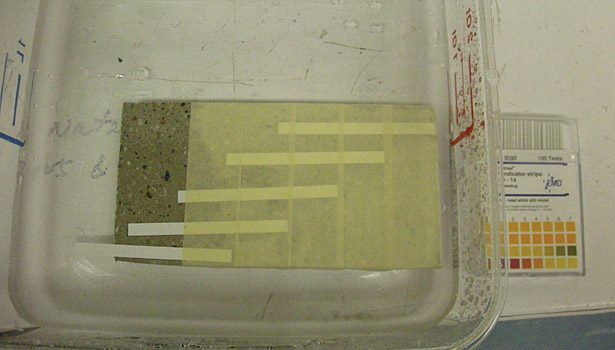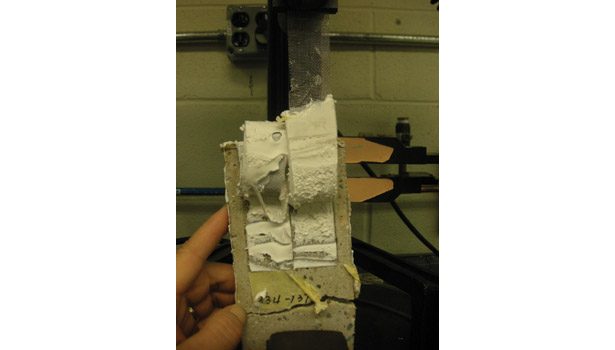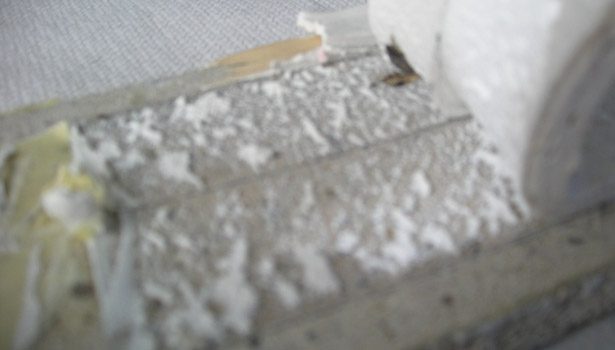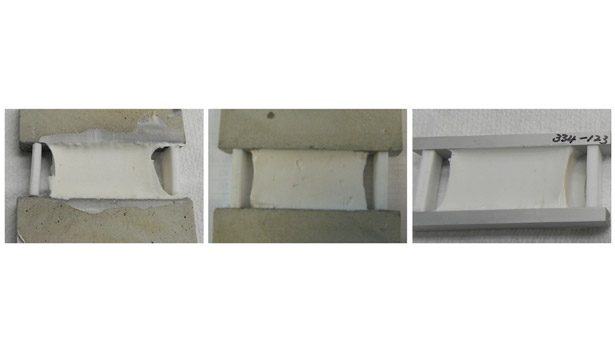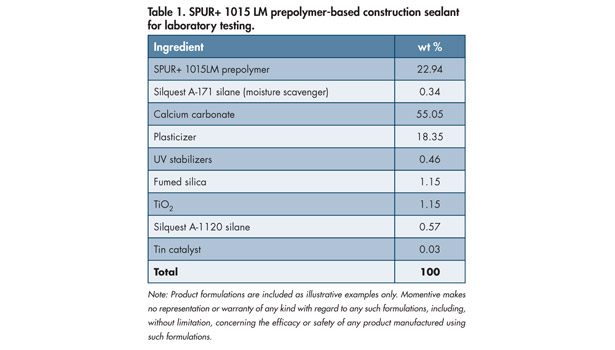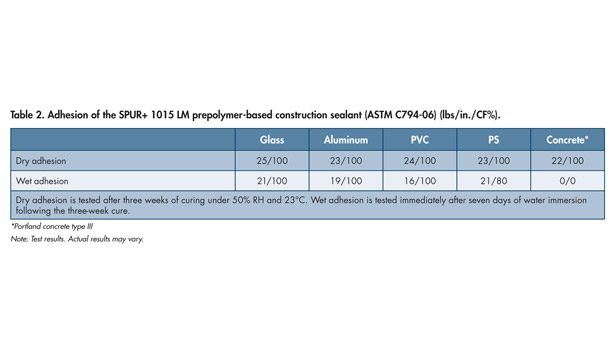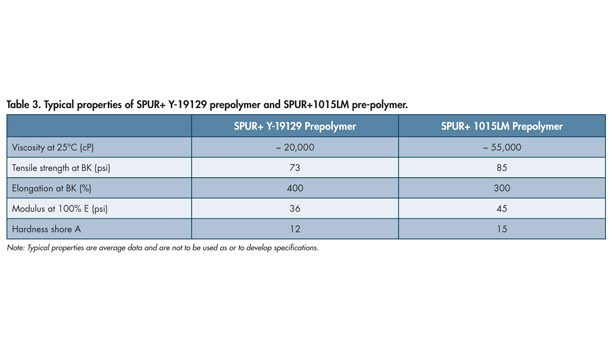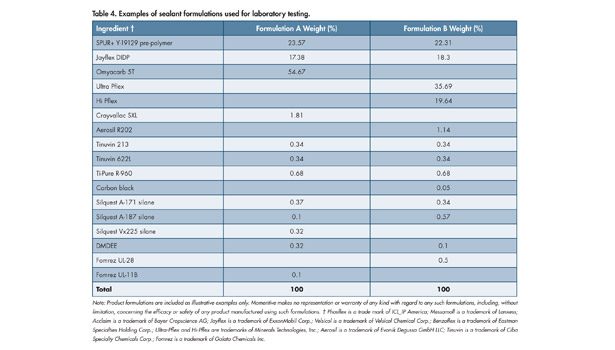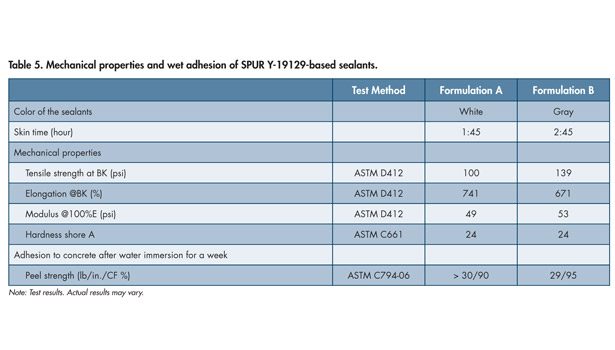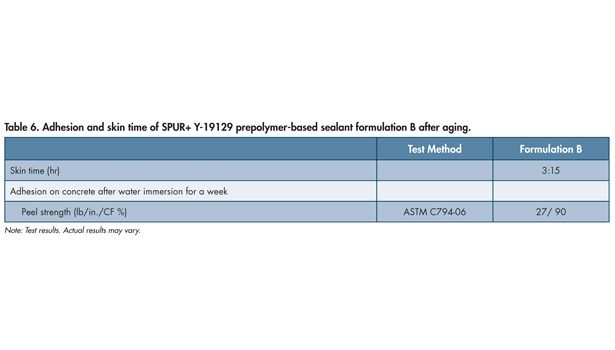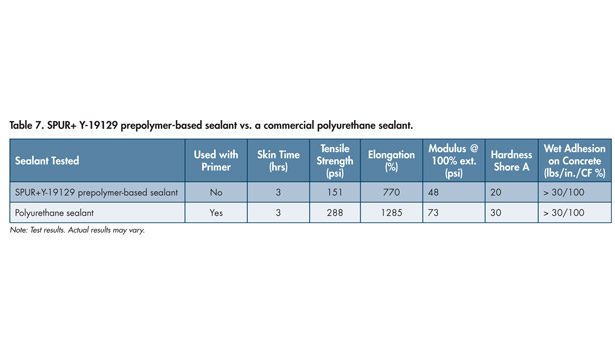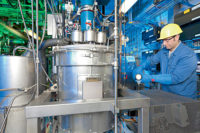Concrete is one of the basic materials used to build our modern world, with applications in civil, commercial and residential constructions. In many structural designs, concrete requires compatibility with applied adhesives and sealants. One of the key challenges faced by today’s construction industry is obtaining durable adhesion of adhesives and sealants to concrete, especially under wet conditions.
The currently available technology to overcome this challenge is the application of a primer layer over the concrete before the adhesives or sealants are applied. However, using a primer increases both labor costs and overall construction time. In addition, most—if not all—primers for concrete contain solvents that may pose worker exposure issues and have high volatile organic compound (VOC) levels.
A new prepolymer may be used to formulate a sealant that provides durable adhesion to concrete (especially under wet conditions) without the use of a primer. This was demonstrated using both U.S. and EU testing norms for adhesion to concrete under wet conditions (ASTM C794-06 and ISO 10590).
Problem and Hypothesis
Formulated sealants based on the current line of Momentive Performance Materials Inc.’s (MPM) SPUR+* prepolymer 1015LM can provide primerless wet adhesion to most substrates used in construction, except concrete (as shown in Table 1 and Table 2). The excellent adhesion to concrete observed in dry conditions disappeared after seven days of water immersion.
MPM has recently developed a new SPUR+ Y-19129 prepolymer to address the lack of adhesion under wet conditions. The new prepolymer may be used to formulate a sealant that allows excellent primerless adhesion under wet conditions to most building substrates, including concrete.
Researchers speculated that the loss of adhesion to concrete under wet conditions was due to the change of alkaline condition at the sealant/concrete interface, leading to decomposition of the adhesion promoter. To test this hypothesis, a simple kinetics experiment was conducted. Several pH papers were taped onto the surface of dry concrete, and the assembly was immersed in de-ionized water. Each pH paper was peeled off periodically to monitor the pH on concrete surface. After the pH plateaued, the assembly was removed from water, and periodic pH monitoring was conducted during the drying process. The results are plotted in Figure 1.
This experiment proved the hypothesis. The pH at the surface of the concrete rose from 5 to 12 in fewer than two hours of water immersion, then returned to a pH value of 7 when the concrete was left to dry. The phenomenon is a result of the reaction of:
2Ca3SiO5 + 7H2O "
3(CaO)•2(SiO2)•4(H2O)(gel) + 3Ca(OH)2
In this reaction, the tricalcium silicate, Ca3SiO5 (also known as alite), is the major mineral phase in Portland cement.2 It can be easily hydrated in water to generate Ca(OH)2 and cause an increase of pH value. It is well known that in such harsh alkaline conditions, the Si-O-X bonds created between silane adhesion promoters and substrates (where X indicates the elements in substrates) would not sustain; therefore, poor adhesion is observed.3
Effects of porosity and dolomites on concretes to the wet adhesion were also studied based on concretes required to use in ASTM 794 (Portland concrete Type III) and ISO 11600 (Mortar M1 and M2). Within these test substrates, the effect of porosity and the size and concentrates of dolomites are minor compared to the impact of water.
Based on the understanding of the property change at the concrete surface under different environmental conditions, a new SPUR+ Y-19129 prepolymer was developed. It has similar mechanical properties as SPUR+ 1015LM pre-polymer, but it can enable primerless adhesion on concrete in wet environments.
New Prepolymer Preparation
SPUR+ Y-19129 prepolymer is a colorless, low-viscosity SPUR+ prepolymer with properties similar to SPUR+ 1015LM. Typical physical properties of the two SPUR+ prepolymers are listed in Table 3. The prepolymers were catalyzed with 1% of dibutyltin dilaurate (DBTDL) and cured in an environmental chamber at 23°C and 50% humidity for a week. The mechanical properties were tested via Instron following ASTM D412 test method for tension properties and ASTM C661 for hardness.
Examples of laboratory test sealant formulations are listed in Table 4. SPUR+ Y-19129 prepolymer-based sealant samples were prepared in a conventional manner using a one-quart, double-planetary Ross mixer equipped with a water-jacketed mix kettle. To ensure good shelf stability, all fillers used were dried during the mixing process under heat and vacuum for at least one hour.
Typically, the SPUR+ Y-19129 prepolymer was mixed with UV stabilizers and a half of the moisture scavenger (Silquest* A-171 silane) first at a low mixing speed for 15 minutes with nitrogen blanketed. Fillers, thixotropic agents and plasticizers were gradually added into the mixer. After all the fillers were wetted into SPUR+ pre-polymer, the mixing speed was increased and mixed at 90°C or higher with full vacuum until the fillers were dried and the sealant became homogenous without any lumps.
After cooling down to 30-40°C, the adhesion promoter, Silquest A-187 silane and/or VX225 silane, was add and mixed under vacuum for 15 minutes. In the last step, the catalyst and optional co-catalyst, such as 2,2’-dimorpholinodiethylether (DMDEE), were added together with the second half of the moisture scavenger, mixed and degassed under light vacuum for another 15 minutes before packing into cartridges.
Property and Performance Testing
Mechanical properties were evaluated according to standard ASTM specifications. Data on tensile strength, percentage elongation, and modulus at 100% extension (ASTM D412) and hardness shore A (ASTM C661) were obtained on samples cured in an environmental chamber at 23°C and
50% humidity for one week (see Table 5). Tack-free times were determined by finger touch under ambient conditions.
The adhesion-in-peel testing on concrete was conducted in accordance with the ASTM C794-06 test specification. The Portland concrete III substrates (3 x 6-in. coupons) were obtained from Mensonary Building Materials in Saginaw, Mich. The substrates were cleaned to bare concrete with brushing and blowing by compressed air gun.
The specimens for adhesion-in-peel tests were prepared as follows: the SPUR+ Y-19129 prepolymer-based sealant was spread over a 4 x 3-in. portion of the substrate to a depth of approximately 1/8 in. The sealant was then covered with two 8 x 1-in. 30-mesh aluminum screens, ¼ in. apart, and then covered with an additional 1/8 in. layer of the sealant. The specimens were cured for three weeks in an environmental chamber at 23°C and 50% relative humidity, followed by one week of water immersion.
The two SPUR+ Y-19129 prepolymer-based sealants had mechanical properties similar to sealants using SPUR+ 1015 prepolymer, but with significant improvements to primerless adhesion to concrete under wet conditions. Formulations A and B used different fillers and thixotropic agents. The test results showed no noticeable differences, suggesting that SPUR+ Y-19129 prepolymer may have broad latitude in formulating. Figure 2 captured the results of the 180 peel test on Instron, where adhesion after water immersion was so strong that concrete coupons often broke during the test. In addition, as shown in Figure 3, adhesion was so strong that a big piece of dolomite (used in concrete preparation) was pulled off from the concrete surface during the adhesion-in-peel test.
SPUR+ Y-19129 prepolymer-based sealant formulations were further tested for shelf stability. A sample was stored in a cartridge and placed in an oven at 50°C. After four weeks, the sealants were tested again for skin time and adhesion on concrete under wet conditions, as previously described. The aged sealant still maintained excellent adhesion on concrete under wet conditions. For example, Formulation B was tested and results are collected in Table 6.
Researchers also compared properties of a SPUR+ Y-19129 prepolymer-based sealant with a commercial polyurethane sealant. As required by the sealant producer, a primer was used before laying down the polyurethane sealant. Table 7 shows the test results: SPUR+ Y-19129 prepolymer-based sealant provided primerless adhesion on concrete under wet conditions that was comparable to that provided by the commercial polyurethane sealant with primer. The two specimens had wet adhesion on concrete higher than 30 lb/in. in peel strength (concrete substrates broke when the peel strength reached 30 lb/in.).
ISO Test Methods
The SPUR+ Y-19129 prepolymer-based sealants were also tested according to European standards, where the equivalent test for adhesion under wet conditions is ISO 10590. The sealants prepared using SPUR+ Y-19129 prepolymer had a classification of LM25 sealant. The purpose of this method was to evaluate adhesion properties at maintained extension after water immersion. It specified the use of concrete substrates M1 and M2, which were prepared according to ISO 113640 specification. The images of the two kinds of concrete substrates are showed in Figure 4; the top one is M1 with a smooth surface, and the bottom one is M2 with a rough surface.
In accordance with ISO 10590, H-Bar specimens (in triplicates) were made with M1 and M2 concrete substrates, as well as aluminum substrates respectively. The specimens were then cured for 28 days in an environmental chamber at 23°C and 50% humidity, followed by four days immersed in water. After removal from the water, the test specimens were required to equilibrate in air at room temperature and 50% humidity. Then the specimens were extended to 100% elongation on tensile test machine and maintained for 24 hours using Teflon separators. To pass this test, the sealant could not delaminate from the concrete during those 24 hours.
The images in Figure 5 were taken after 24 hours of stretching at 100% extension. Neither delamination nor cracking was observed on any of the test specimens.
According to ISO 7389, the elastic recovery test was conducted on the specimens after 24 hours of extension, and the spacers were removed. The test specimens were then placed vertically on a talc-dusted glass surface for one hour. The width between the two substrates was measured before and after the one-hour standing, and then used in the calculation of percentage recovery. ISO 11600 sealant classification requires the elastic recovery be higher than 70%. SPUR+-based sealants have fulfilled that requirement. Both ISO 10590 and ISO 7389 test results are provided in Table 8.
Conclusion
Most buildings use concrete to provide structural integrity. This concrete typically comes in contact with other building elements such as windows, façades, etc., and these dissimilar surfaces are often “joined” together by sealants. For the integrity of the structure, it is critical that the adhesion between the sealant and the substrates (e.g., concrete with windows, façades, etc.) sustains various environmental stresses like rain, sunlight, and temperature changes. The adhesion between sealant and concrete is particularly challenging on exposure to rain due to very aggressive (high pH) environment in concrete.
Currently available sealants require a primer to retain adhesion under wet conditions, which increases the construction cost and the levels of VOCs. However, a new SPUR+ prepolymer-based sealant can retain adhesion to concrete under wet conditions without the use of a primer. This adhesion was demonstrated using both U.S. and EU testing norms for adhesion to concrete under wet conditions (ASTM C794-06 and ISO 11590).
For more information, visit www.momentive.com.
References
1. Landon, Shayne J., Dawkins, Neville B., and Waldman, Bruce A., “Hybrid Sealants Demonstrate Enhanced Adhesion to Plastic Substrates,” Adhesives & Sealants Industry, March 1997.
2. Mindess, Sindey, and Young, J. Francis, Concrete, Prentice-Hall, Inc., 1981.
3. Szmant, H. Harry, Organic Building Blocks of Chemical Industry, John Wiley & Son, 1989.
*SPUR+ is a trademark of Momentive Performance Materials, Inc.
